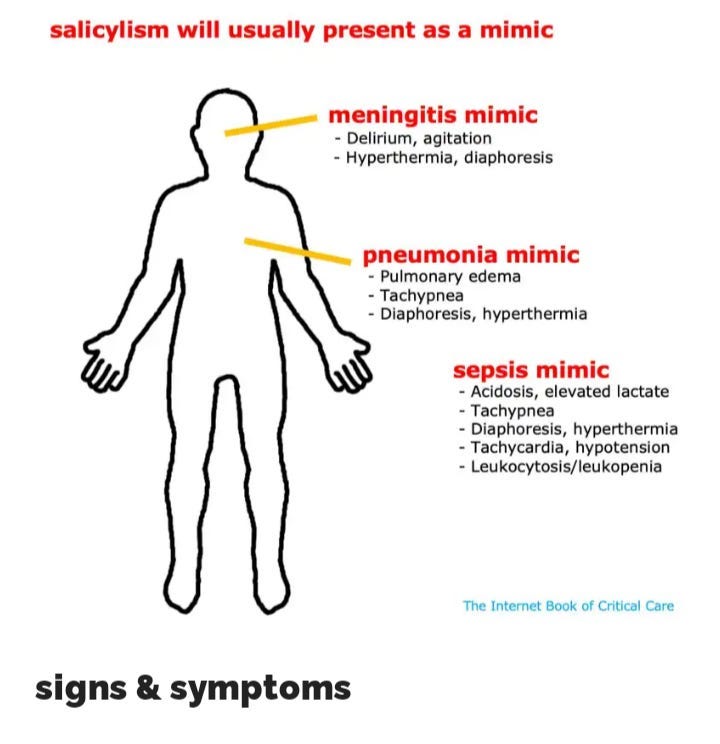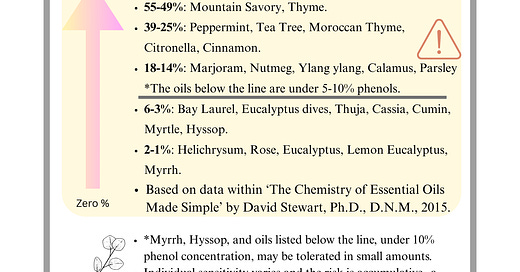Phenol sensitivity and Essential Oils - new graphics
I've shared this info in prior posts, but have organized it into handouts.
Essential oils can be very health promoting, but for people with a metabolic difficulty processing benzene-ring phenol type of chemicals or salicylates, then many essential oils or blends with commonly used oils might cause negative effects.
Or, for people with normal metabolism, the list of higher phenol oils can be used to help create your own blends. Additive, synergistic benefits, occur when essential oils with monoterpenes, sesquiterpenes and phenylpropanoids are used in a combined blend.
My post with these graphics in text and in a smaller size. If interested in Essential Oils, my archives have quite a few posts, check ‘Essential Oil Book Club’, ‘essential oils’, and I may have Cypress, Ylang ylang, and a few others as individual oils in my post tags/’Key Words’.

Phenol sensitivity and essential oils rich in phenylpropanoids; terpenes might be better tolerated.
People who are sensitive to salicylates would need to avoid Wintergreen, Peppermint, Spearmint, Birch, Hyssop, Wormwood Essential Oils, and possibly limit Ylang Ylang Essential Oil too but it has very little compared to Wintergreen or Birch. See: Methyl Salicylate: Essential Oil Constituents in Food Part 5, by Robert Tisserand, (link).
Which carrier oils are used is also a factor with salicylate or amine sensitivity. Olive oil, especially good quality Extra Virgin cold-pressed olive oil is high in salicylate and coconut oil can provide too much too. Lower salicylate oils however include seed oils which are high in omega-6 fatty acids and not great choices for that reason.
Canola
Cottonseed
Sunflower
Safflower
Soy
Palm
Rice Bran Oil, ‘Safe oils and moisturizers for the body that are low in salicylates and amines’, (link)
My Take home point - try to correct an overacidity or low glycine problem so salicylate is processed better again and then more of the healthy oils and herbs and spices and produce can be consumed safely.
Plant salicylates have anti-cancer benefits and on average are associated with health. For the sensitive though, salicylate excess causes a variety of odd symptoms that tend to get diagnosed and treated as a handful of diagnoses, and reducing salicylate intake or correcting overacidity or lack of glycine is typically not an educational message for the wrong ‘diagnoses’. The symptoms might be called asthma, leg lymphedema, digestive upset/gassy bloating, and tachycardia/heart arrythmia. Salicylate misdiagnosis is frequent rather than unusual, even when severe enough to be life threatening. “Pneumonia”, “meningitis”, or “sepsis” might be the wrong diagnosis. If salicylate excess is the issue, the symptoms will reverse once the salicylate intake is reduced to minimal but will continue to worsen until the salicylate excess is corrected.
A misdiagnosis can be a little like a death sentence…. a lung transplant would not help if salicylate excess was the actual underlying problem of “pneumonia”.

“Food or Chemical Sensitivity” = a metabolic problem rather than an ‘allergy’. The person has difficulty breaking down or excreting groups of chemicals. This may be a gene difference but can also be a correctable issue of a body that is overly acidic (carbonated pop/coffee/ other beverages, or a high meat/dairy diet, low magnesium). Or a diet or gene issue leading to being low in glycine are risk factors for salicylate sensitivity that are modifiable rather than a lifelong gene difference).
*Personal news update - my astrophysics Summary was not accepted by the journal but I will keep working on the model and publishing the more provable parts.
Disclaimer: This information is being provided for educational purposes within the guidelines of Fair Use and is not intended to provide individual health care guidance.







